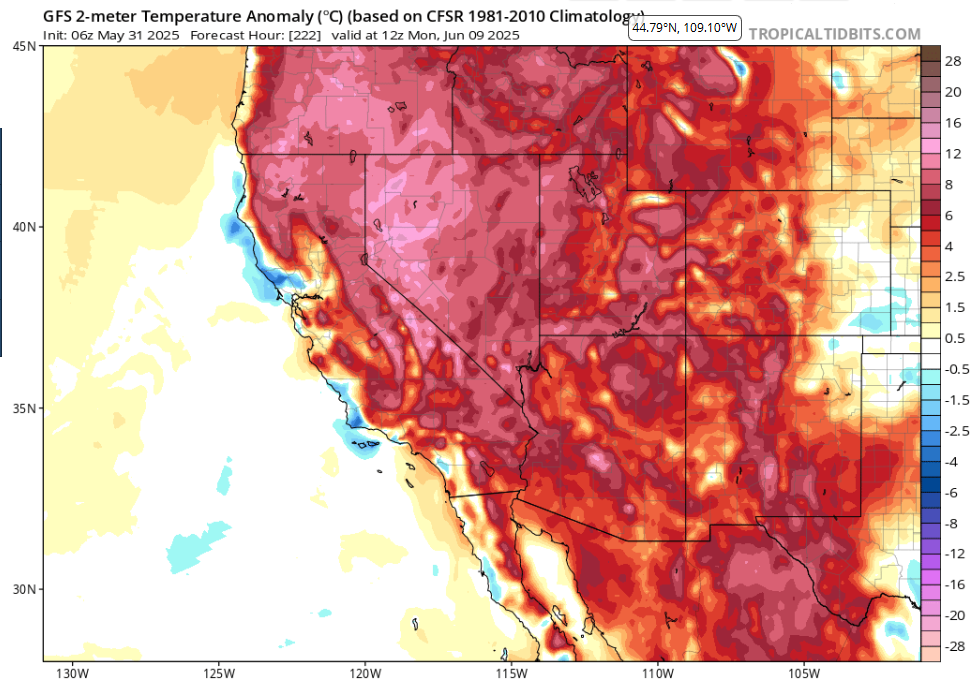
As June 2025 progresses, a persistent and widespread heatwave is gripping large parts of the western United States, Mexico, Canada, and Central America. This surge of high temperatures is setting records, stressing energy grids, worsening drought conditions, and raising concerns for vulnerable populations.
California and the US West: Record-Breaking Heat and High Fire Risks
California is at the epicenter of this early summer heatwave, with multiple cities recording some of the highest temperatures seen this early in the season. Sacramento and Fresno have seen daytime highs soaring between 38°C and 41°C (100°F – 106°F), while parts of the Central Valley are experiencing temperatures near 43°C (110°F). Southern California cities like Los Angeles and Palm Springs are also baking under intense sunshine, with forecast highs reaching 35°C to 40°C (95°F – 104°F).
This heatwave extends well beyond California. The US West, including Nevada, Arizona, and parts of Oregon and Washington, is experiencing similar temperature spikes. Phoenix, Arizona, reported highs around 44°C (111°F), consistent with the region’s early summer norms but still stressing energy and water resources. Seattle and Portland, typically cooler, have seen unseasonably warm temperatures climbing into the high 20s Celsius (mid-80s Fahrenheit), a significant departure from seasonal averages.
Mexico: Scorching Temperatures Across Northern and Central Regions
Northern Mexico is enduring some of its hottest weather on record, with cities such as Hermosillo and Monterrey pushing temperatures to 43°C – 45°C (109°F – 113°F). These scorching conditions have led to increased power demands and warnings about water shortages. Central Mexican states including Guanajuato and Queretaro are also experiencing above-normal temperatures, generally in the mid to upper 30s Celsius (mid-90s to low 100s Fahrenheit).
The Mexican government’s National Meteorological Service has issued heat advisories, encouraging residents to limit outdoor activities during peak afternoon hours and to stay hydrated, especially vulnerable groups like children and the elderly.
Canada: Early and Unseasonably Intense Heatwave
While Canada usually warms up later in the summer, this year’s heatwave has pushed temperatures well above normal for early June. Cities in southern Ontario and Quebec, such as Toronto and Montreal, have experienced highs around 30°C – 33°C (86°F – 91°F), which is notably warm for this time of year. These early heat spikes are straining energy systems and increasing demand for cooling.
Further west, Calgary and Edmonton in Alberta are also seeing daytime temperatures climbing into the mid-20s Celsius (mid-70s Fahrenheit), well above typical early June averages. The early arrival of such heat is raising concerns about the length and severity of the upcoming summer season.
Central America: Hot and Humid Heatwave Amid the Rainy Season
Central American countries including Honduras, Guatemala, and Nicaragua are battling intense heat coupled with high humidity. Daytime highs regularly reach 32°C – 35°C (90°F – 95°F), but the high humidity makes the heat feel much more oppressive. Even nighttime temperatures remain elevated, often not falling below 24°C (75°F), limiting relief from the daytime heat.
This heatwave arrives during the rainy season, creating uncomfortable conditions for many and elevating risks for heat-related illnesses. Local health authorities have issued advisories emphasizing hydration and caution during outdoor work or activities.
Meteorological Factors Driving the Heatwave
A large, persistent high-pressure system, often referred to as a “heat dome,” has been anchoring over the western US and adjacent regions. This system traps warm air near the surface, reduces cloud cover, and suppresses cooling night-time breezes, allowing heat to build up day after day.
In Mexico and Central America, the combination of tropical ridging and the seasonal shift in atmospheric circulation is amplifying heat and humidity. Meanwhile, the unusual early warmth in Canada is linked to a rapid northward push of warm air masses, possibly influenced by broader climate change trends.
Outlook and Impacts
The heatwave is expected to continue intensifying through mid-June before gradual relief arrives via a series of Pacific cold fronts and monsoonal moisture moving northward. However, temperatures will likely remain above seasonal norms well into the month, prolonging stress on energy grids and increasing wildfire risks, particularly in California and the US West.
Agricultural regions across the US West, Mexico, and Central America are vulnerable to heat stress impacting crops and livestock. Urban areas face public health challenges related to heat exhaustion and heatstroke, particularly among the elderly, children, and outdoor workers.
Residents across affected areas are advised to:
- Stay hydrated and avoid outdoor exertion during peak heat hours (midday to late afternoon).
- Use cooling centers and air conditioning where available.
- Monitor local heat advisories and wildfire warnings.
- Prepare for potential power outages due to grid strain.


Temperature anomalies from Mexico to Canada on 9. June 2025. Source: https://www.tropicaltidbits.com/analysis/models/?model=gfs®ion=swus&pkg=T2ma&runtime=2025053106&fh=222


























